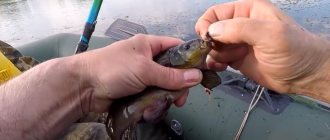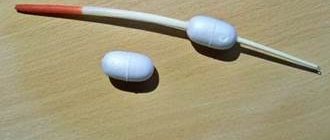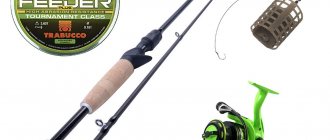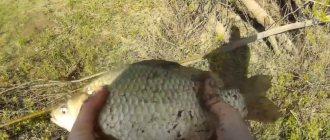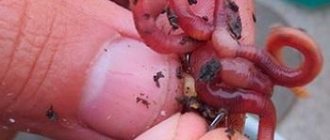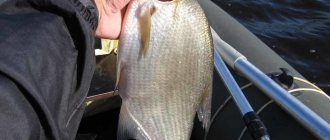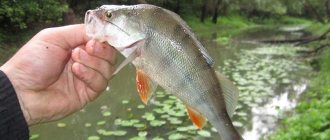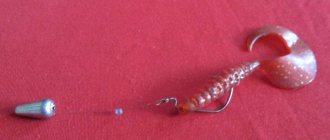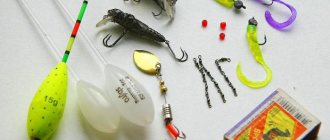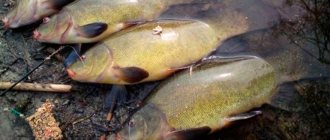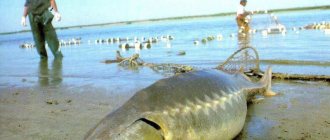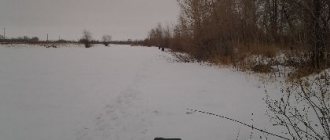Tench is a freshwater fish from the Carp family that loves the warm season and stagnant bodies of water. Therefore, biting activity depends primarily on weather conditions.
As soon as the water in the reservoir has time to warm up to 10°C, you can go line fishing. Hunting for a representative of the Karpov family is very interesting. Fish is distinguished not only by caution, but also by cunning. Catching it on a hook is not so easy, so the feeling of excitement will not leave you throughout the entire fishing trip. Below you can get acquainted with the peculiarities of catching tench in the spring using different gear and advice from experienced fishermen.
Tench is a beautiful fish - it’s not easy to catch, it bites especially poorly in early spring
Peculiarities of tench behavior in spring by month, when fish begin to bite
During the period when the water in the river warms up to 13°C, the tench wakes up, comes out of its sleepy state, and the spring feeding begins in the ray-finned fish of the carp family. Tench actively searches for insect larvae, trying to replenish its strength after winter.
March
The fish begins to be active only at the end of March. You can use a worm or a leech as bait. The bites at this time of year are not as careful as in the summer months. When fishing promising places for fishing, you should not make noise so as not to scare off the tench.
Fishing for tench in early spring in March after the ice melts - video lesson:
Tench fishing in April
Mid-spring is considered a better period for fishing than March. It is best to go fishing on days when there are no sudden changes in water temperature, as well as sudden gusts of wind.
May
Tench is not a schooling fish, however, at the end of spring it gathers in schools. At this time, universal animal bait will be the most effective; you can use a worm, bloodworm or maggot.
Tench biting calendar
Where to catch tench in May with a float rod?
Tench begins to peck already with the arrival of spring, but the most active pecking begins in the month of May. It is during this period that you should go to the reservoir for tench. This is a peaceful fish that can inhabit both flowing water bodies and bodies of standing water. The fisherman's task comes down to finding a promising place. Similar places can be found on any body of water.
Promising places include:
- Areas of water characterized by a muddy bottom.
- In places where there is dense aquatic vegetation.
- In places where reed growth is observed. Here the tench can simply hide and rest.
- In places where there are fallen trees. Such places attract many fish, including tench.
Choosing a place to catch tench in May
During this period, the tench's menu consists of amphipods, which are abundant in areas where the bottom is muddy. Tench looks for food where the thickness of the silt is no more than 20 cm. In general, the bottom should be hard.
If the thickness of the silt layer is more than 20 cm, then tench are unlikely to feed here, since such places are characterized by an excess of gases released by silt. This happens because organic matter rots in such places and bugs or worms have nothing to do here.
If you can find thickets of horsetail, then this place should be examined for the presence of tench. Such water areas are characterized by a thin layer of silt, which attracts them.
Reed thickets should also be considered promising places. The bottom in these places is quite attractive for tench, since here it can find a source of food.
Best time to fish
With the arrival of spring, the water begins to gradually warm up: first in shallow waters, and then in deeper waters. As soon as the water begins to warm up, various algae begin to grow. When the first young shoots appear on the surface of the water, it’s time to go catch tench. Of course, it is caught earlier, but with the beginning of this period its biting is most active. With the beginning of the growth of aquatic vegetation, the fish have the opportunity not only to feed themselves, but also to hide from the ubiquitous predators. Tench, hungry after winter, begins to actively feed, restoring its strength. During this period, he does not sort out baits and is not very careful, but with the arrival of summer, he becomes as careful as possible, sorting out baits.
Tench does not lead a school life, but in the month of May its behavior differs in that tench gather in schools. Therefore, it is during this period that it makes sense to go fishing in order to stay with the catch.
Where to look for tench in spring
Having arrived at a reservoir for line fishing, every angler asks the question - where to look for fish sites? A representative of the carp family prefers coastal shallows without current. The fish stays close:
- coastal reed thickets;
- reeds, at a depth of up to 3 meters;
- coastal cattail thickets.
Tench stands among the water lilies.
Experienced fishermen recommend fishing in bays where the water warms up faster than in other places in the lake or river. The favorite habitat of beautiful and strong fish are areas of the reservoir with a muddy bottom, as well as long gentle slopes.
Interesting to know! In spring, it is best to go fishing early in the morning or from 16 to 19 pm. During the day the fish rests, so the bite is poor.
Don't wait until summer!
Tench lives in oxbow lakes, lakes and shallow river bays overgrown with grass. That is why it is almost impossible to catch this fish in the summer - try, pull it out of the dense thickets.
What to catch?
As a rule, tench is caught with a regular float rod. Choose a long and sensitive float, such as a thin goose feather. Line - 0.2-0.25 mm, hook - No. 4-5.5. We recommend using a small dung worm or a bunch of bloodworms as bait.
What gear is used to catch tench?
Before going to a pond, it is important to familiarize yourself with the peculiarities of fishing for freshwater fish. You will also need to prepare suitable gear, baits and bait.
Features of fishing with float tackle
Perhaps the most popular gear for catching tench is a float.
Tench is an individualist that lives in thickets, so you should look for it in shallow areas with underwater vegetation. The length of the rod for float fishing should reach 5-6 meters. The recommended main line diameter is 0.25 mm. To make a leash, it is better to use 0.18 mm fishing line.
You will also need:
- float;
- lead pellets for the weight;
- hooks No. 8.
Tench is an omnivorous fish. In search of food, a representative of the carp family buries itself in the mud, so bites will occur even if the bait sinks into a layer of mud.
The best spring baits in early spring in March-April, which attract the attention of even well-fed fish, are considered to be: dung worms, tinted red maggots, bloodworms, and small leeches.
Tench really like a sandwich of maggots and worms and in the spring in March-April it is the best bait when catching tench on a float
In May, you can also add vegetable baits to the above listed baits - semolina, dough, mud, corn.
The bait mixture can be purchased at a fishing store or prepared with your own hands by combining a small amount in a deep container:
- steamed corn;
- chopped animal bait;
- cereal bran;
- oatmeal;
- wheat flour;
- makuhi.
How to properly load a float on a fishing rod when fishing in still water.
Bait should consist of coarse-grained components. You can use flour or oatmeal as a binding ingredient.
Catching tench in the spring with a float rod - video from the shore of the reservoir:
Features of fishing with a feeder
To catch tench on a feeder, you should find a clean and quiet body of water with rich underwater vegetation. A representative of the carp family prefers shallow water areas in the spring, so fishing should begin from such places.
For bait you can use boilies, corn and animal baits - a worm, a bunch of maggots.
When fishing on a feeder, boilies are important
Bait can be purchased at a fishing store. A mixture intended for catching tench, carp, as well as a universal option is suitable. It is recommended to add a small amount of canned corn and maggots to the bait.
Feeder rigs for tench fishing
Feeder tackle is assembled on the basis of a fishing rod, the length of which reaches 3 meters. The casting of the form should be within 10-40 degrees.
The reel used is inertia-free and has a friction brake. The functions of the main fishing line are performed by a monofilament fishing line, the diameter of which reaches 0.18 mm. The size of the hooks depends on the size of the nozzle.
Note! Feeders are mounted on a fishing line using a symmetrical loop; this is the best installation option for standing reservoirs.
A symmetrical loop is one of the best types of installation for standing water
Fishing for tench on a feeder in spring in April:
Features of donk fishing
For spring fishing for tench on a donk, a simple tackle, the length of which reaches 2-3 meters, is suitable. A spinning reel is fixed to the bottom, the spool volume of which is in the range of 2000-3000.
A fishing line (0.25-0.3 mm) is wound onto the reel. When choosing a sinker, you should give preference to the sliding flat option. A pair of leashes with No. 8 hooks are tied to the main line. One of the leashes is fixed above the weight, and the second to the swivel.
When fishing for fish on a donk, you should use a bait mixture that contains a small amount of:
- steamed hemp;
- chopped crawlies;
- cake;
- steamed corn kernels.
When you arrive at a pond, you can add an earthworm and a red worm to the mixture.
Crawlers, caddis flies, bloodworms, and bark beetle larvae are placed on the hooks.
Donka with a spring for bait
Catching tench with a spring
A spring is considered a variation of a bottom feeder, which is made on the basis of thin metal wire or plastic. The shape of the spring is elliptical or spindle-shaped. A pair of leashes with small hooks are fixed from the back of the feeder. To make leashes you will need to use thin monofilament leashes or braided leashes.
Spring for catching tench, crucian carp, crucian carp
The process of fishing a tench with a spring cannot be called complicated. First of all, the fisherman prepares a viscous and fairly dense bait mixture, which includes boiled millet.
Bait is placed on the hooks, and feeders are filled with bait porridge. Red and earthworms and steamed peas are most often used as bait. You can also purchase maggots, which are planted in groups of 5 at a time.
It is very important that the bait is fresh, otherwise even a hungry fish will not want to eat it.
Before planting, worms and maggots are treated with a small amount of hemp and anise oil. The hooks are hidden in the bait, inserted between the coils of the spring. After this, the angler checks with a couple of casts how tightly the mixture is held in the feeder when it hits the surface of the water.
The tench, attracted by the aroma of the bait, approaches the feeder and sucks up the mixture, opening its mouth wide. This way the hooks will end up in the fish's mouth. After this, the fish, suspecting something was wrong, makes a sharp jerk.
If the fisherman took care of selecting the correct weight of the feeder, then at this moment self-notching should occur. However, you shouldn't tempt fate. As soon as sharp jerks in the tip of the tackle appear, you should hook and bring the fish ashore.
Fishing with a jig with a side nod
Jigs are often used by anglers when fishing for tench in the spring. When equipping a fishing rod with a side nod, it is important to take into account the following nuances.
- The recommended rod length reaches 5-7 meters.
- A reel with fishing line is tied to the tackle form. The thickness of the monofilament is in the range of 0.18-0.20 mm.
- A dung worm is attached to the hook, and a lead jig is attached to the tip of the fishing line.
- The tip of the rod is equipped with a side nod made from a plastic bottle. The side nod clearly determines the moment of hooking and makes the jig play.
Interesting to know! In order to change the fishing distance, you should move or spread the knees of the tackle.
Side nod design
Gear device
The main gear for tench is a float rod. The choice of such a tool is determined by the following factors:
- A long cast is not needed; a sufficient distance most often does not exceed 5-7 meters from the shore.
- It is required to accurately deliver the equipment to the fishing point, sometimes located in the “windows” of aquatic vegetation.
- Carefully select the descent of the tackle, you need the bait to lightly touch the bottom, and not lie on it. With this arrangement, the number of realized bites increases noticeably.
In such conditions, you can only fish with a float! Attention! Tench can peck for a very long time, savoring the bait. A worm lying on the bottom will attract fish, but there will be no signal to the float until it is directly swallowed and pulled, which in this case can be skipped. Therefore, tench hunters most often prefer either fly fishing rods five to seven meters long, or four-meter “laptops”, equipped with spinning reels when longer casting is required
Therefore, tench hunters most often prefer either fly fishing rods five to seven meters long, or four-meter “laptops” equipped with spinning reels when longer casting is required.
Having decided on the type of fishing rod, we will begin to equip it. To begin, we will wind a Bolognese fishing rod onto the reel or tie a fly fishing line to the connector. For strong fish, which is a tench weighing over a kilogram, and we are not interested in anything else , we will not waste time on trifles, and take a monofilament with a diameter of 0.22-0.25 millimeters.
Our equipment will be blind, there is no need for running, so we put a spindle-shaped float on the fishing line with two or three attachment points. The weight of the float should not be particularly large; the extreme value usually does not exceed two grams, although you can get by with something lighter, like a goose feather.
Goose feather is a classic of float fishing: light, sensitive, inexpensive!
We should also talk about loading gear. As mentioned above, if the bait lies on the bottom, as we usually catch crucian carp, you can easily miss the line bite. Therefore, in our case, we rebuild as accurately as possible:
- Depending on the weight of the selected float, we select the mass of weights; it is advisable to take at least four of them with different weight distributions.
- We attach the weights to the fishing line, starting with the largest, gradually decreasing the size towards the leash.
- The last of them is a sub-hook, we install it 7-10 centimeters from the hook if we use equipment without a leash.
Attention! Some fishermen use a miniature swivel as a backup. The presence of this element allows you to quickly replace the leash with a hook
With this installation, it is easy to “hang” the hook so that the worm is positioned touching the bottom, and the equipment is in tension. Only this position will transmit the slightest touch of the fish to the bait to the float, and, therefore, will signal the fish’s interest in the bait.
The next element of the equipment is the leash. Many anglers neglect it, although in most cases this is not true. A thinner line is needed for:
- equipment camouflage;
- protection of the tackle in the event of a break - only the leash will come off;
- prompt replacement of the hook.
We finish constructing the tackle with a crochet hook. His choice is determined by a single factor - bait. For fishing with a worm you should take numbers 3-5, for maggots 6-8, for bloodworms - 14-16 according to the international classification. At the same time, many fishermen note that in line fishing it is imperative to mask the sting, although the issue, of course, is controversial.
When baiting a worm with a stocking, the sting of the hook is hidden, but other baiting methods can be used.
Fishing for tench in spring from a boat
You can fish for tench not only from the shore, but also from a boat. To do this, you will need to anchor the boat.
The cast is made towards the shore so that after hooking it is possible to move the fish away from the thickets. When choosing a place for fishing, you should pay attention to the direction of the wind, since casting light equipment in a headwind is problematic.
The recommended length of the gear is 3 meters. The bait and bait used is the same as when catching tench from the shore.
Do not forget about the restrictions that exist on the use of swimming equipment in the spring.
Lifehacks and tips from experienced fishermen
Use the following components for bait, they will help you improve the bite and attract fish:
- Oatmeal or flour;
- Breadcrumbs;
- Cocoa;
- Egg powder;
- Cornmeal or corn.
Wait patiently for a bite as long as necessary, since tench are quite picky and careful. At an early stage of the bite, the float may sway a little and go in different directions, this means that it is trying your bait.
If something alerts her, the bite will stop immediately. Use baits that have been tested in this body of water as it is quite finicky. For bait, you can use oatmeal, which you can steam at home in a thermos, and then, when fishing, drain the water and dry the grains a little. You can put 2-3 grains on the hook.
Tips and secrets
Avid fishermen share useful tips and secrets for catching tench:
- Fishing is most effective in the morning and evening hours.
- The optimal carrying capacity of the float is considered to be in the range of 2-2.5 grams.
- Tench is a shy fish, so it is important to avoid noise while fishing.
- It is unacceptable to rush into hooking. If the tip of the tackle shakes, you cannot hook. At this moment, the tench is just trying the bait. With sharp jerks of the tip of the fishing rod, it will be possible to hook and land fish on the shore.
When fishing some reservoirs, fishermen note that not only store-bought baits work well, but also homemade mixtures containing wheat grains, bran or corn.
If there are no bites for a long time, it is worth experimenting with baits and groundbaits. Perhaps the fish will like a different bait option.
It is difficult to find a fisherman who has not caught tench at least once in his life. Catching shy and cautious fish is not easy, but that’s why it’s interesting.
It is important to avoid noise while fishing so as not to scare away a member of the carp family. By following the advice of experienced fishermen, which are listed in the article, even on the worst day you can not be left without a catch. Let the float play tirelessly, and the fish don’t get off the hook!
Bait and groundbait
Spring tench has an excellent appetite. Diet: red worms, maggots, larvae of burdock moths rich in animal protein, as well as the king among spring baits - bloodworms.
Crawling - the best bait for catching large fish
8 float attachments
DIY coin spinner
In early spring, you can also use protein dough or mask to catch tench. Large tench practically do not change their diet throughout the spring. Medium and small tench can also be caught in the second half of spring using steamed or boiled cereals or “sandwiches”.
Feeding tench during this period is a thankless task. The risk of scaring him with splashes is too great. Privada works much more efficiently on a reservoir. Yes, it takes more time. But a piece of turf stuffed with a worm or maggot, placed on the bottom of a reservoir for several days, will have a much greater effect than kilograms of branded bait thrown onto the bottom directly on the day of fishing.
MINI TIPS FOR FISHING TENCH
· It is useless to look for tench in reservoirs with a sandy or clay bottom. This fish lives only in places where there is silt. Rummaging in it, the tench gets its food.
· It is also known that tench often appears among horsetail thickets. If there are such places on the reservoir, it makes sense to fish there too.
· Tench does not like currents. It should be caught only in standing water, at shallow depths - up to 1.5 m.
· The weight of tench sometimes reaches 3–4 kg, but fish of this weight are found only in river bays or in flowing lakes and ponds. In closed reservoirs, with rare exceptions, the weight of tench does not exceed 0.6–0.8 kg.
· The beginning of spring zhora near tench coincides with the beginning of lilac flowering.
